Brian Meert's Blog, page 102
November 2, 2018
Facebook’s Video Creators Launchpad Offers Support, Cash, and Viewers
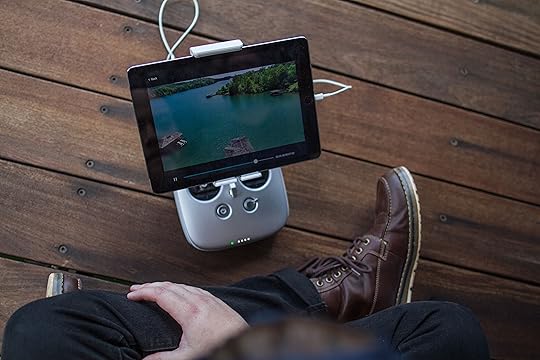 November 2, 2018
November 2, 2018Anne Felicitas, editor at AdvertiseMint, Facebook ad agency
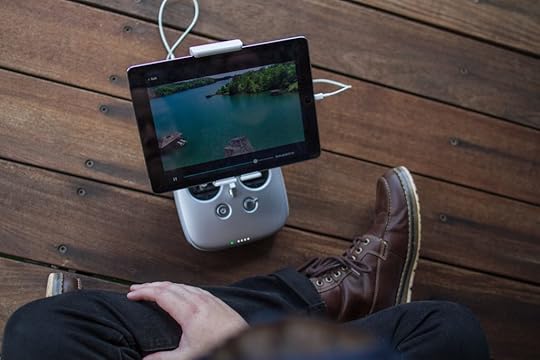
It’s a fun position, video creator, bringing the creative visions swirling inside your head to life. However, being a video creator can be hard. Increasing your viewership, earning money, and pleasing your followers are only a few of the challenges video creators face.
Now, you no longer have to face those challenges alone.
Recently, Facebook created a program called Creators Launchpad intended to help propel video creators like you to success. With Launchpad, creators can grow their audience, earn monthly cash bonuses, and receive strategic support directly from Facebook’s marketing partners. The six-month program also grants access to video monetization with Ad Breaks.
If you want to be a part of this program, apply here. Facebook will review your application and notify you of your eligibility within a few weeks after submission.
Written by Anne Felicitas, editor at AdvertiseMint, Facebook ad agency
The post Facebook’s Video Creators Launchpad Offers Support, Cash, and Viewers appeared first on AdvertiseMint.
November 1, 2018
New to Google: A New Follow Feature for Following Businesses on Maps
Anna Hubbel, writer at AdvertiseMint, Facebook advertising company
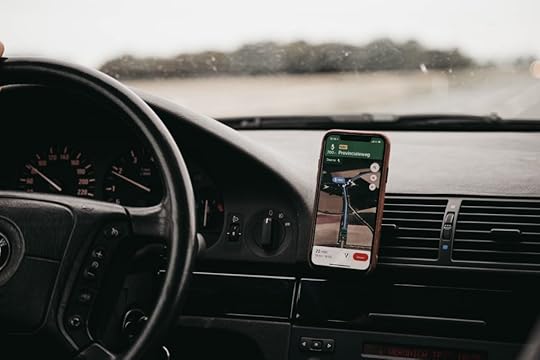 Isaac Mehegan / Unspalsh
Isaac Mehegan / UnspalshThere’s more to Google Maps than just getting directions, especially now with the release of the latest Follow feature that allows you to follow businesses on Google Maps. The feature bears close resemblance to Facebook pages, which also allow you to follow specific businesses to stay up-to-date on related news and events.
As Tech Crunch reports, Google has been releasing various features to Google Maps as of late. For example, group trip planning, music controls, commuter tools, ETA sharing, and personalized recommendations are just some of the new features to Maps. With the new Follow feature, the Maps experience becomes more than just an app for destination discovery: it becomes an ongoing marketing opportunity for businesses.
How It Works
According to Tech Crunch, to use the new Follow feature, you simply tap it for the business you want to track in Maps. You will then be kept up-to-date on all news, events, and offers related to the business in the For You tab.
For businesses, the new feature will help market their profile further than just giving audiences addresses and directions. If your business hasn’t even opened yet, you can still benefit from Google Maps. All you have to do is create a business profile via Google My Business, specify your opening date, and then wait to see the magic happen. Google Maps will share your business with users on mobile web and within the Maps app up to three months prior to your opening day.
During that time, users can choose to follow your business to stay updated on your business’s journey.
Tech Crunch says the over 150 million existing locations on Google Maps will have the Follow feature. It’s initially rolling out on Android over the next few weeks.
Facebook Pages vs Google Maps
We’ve primarily considered Google’s main rival as Amazon, but the latest efforts promoting Maps indicates the platform is homing in on Facebook as well. Facebook pages have famously helped foster relationships between businesses and customers. This has been especially helpful to local business owners who rely on foot traffic.
Google Maps is already used at a massive scale for locating nearby businesses. All you have to do is type and search. There are little to no extra navigating steps to find what you’re looking for. Adding new marketing perks to the mix will further make the business-customer relationship a seamless experience.
In other words, Facebook has its work cut out for it.
Written by Anna Hubbel, writer at AdvertiseMint, Facebook advertising company
The post New to Google: A New Follow Feature for Following Businesses on Maps appeared first on AdvertiseMint.
New to Snapchat: The Snap Camera, a Desktop Feature
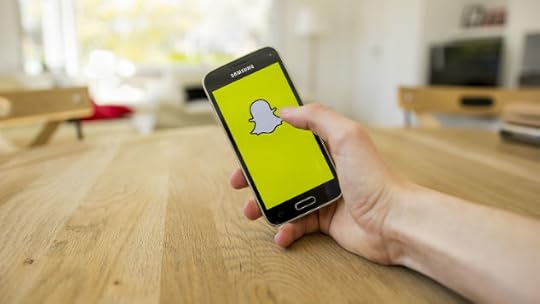 November 1, 2018
November 1, 2018Anna Hubbel, writer at AdvertiseMint, Facebook ads company
 Photo Courtesy of Paste Magazine
Photo Courtesy of Paste MagazineConference calls are about to get a whole lot more interesting. The Verge reports that parent company Snap is introducing the Snap Camera to desktop. The feature, which is available to Mac and Windows users now, allows you to add Snapchat filters while using camera apps like Twitch, YouTube, Skype, and Zoom. Snap made the announcement at TwitchCon.
Whether you’re poking friendly jabs at your fellow players while playing an online game or feeling silly during a conference call with your peers, the Snap Camera brings the augmented-reality revolution of Snapchat to the comfort of your computer.
How It Works
In order to use the Snap Camera on your desktop, you’ll need to install the app by downloading it from the Snap Camera web page. You then set it as your camera output in a third-party desktop application. Once it’s all set up, you’ll have access to all of Snapchat’s lenses, which include those made by the app, as well as community lenses made with Lens Studio.
Adding to the perks, you can also save lenses to your favorites, search, and browse to your heart’s content. You don’t even need to have a Snapchat account to use Snap Camera for desktop; the feature doesn’t have a login option.
 Photo courtesy of The Verge
Photo courtesy of The VergePromoting Community Creativity
According to The Verge, the Snap Camera app for desktop will help promote community lenses made through Lens Studio. Lens Studio is a Snapchat desktop tool that allows developers to create their own unique AR lenses. It opens the door for AR marketing campaigns that can attract Snapchat users who like to play with a variety of lenses to have fun.
“We’re trying to find new distribution channels for those creators to surface their work,” Eitan Pilipski, Snap’s head of camera platform, told The Verge. “We think this a very unique opportunity, bringing Snapchat AR experiences to the desktop.”
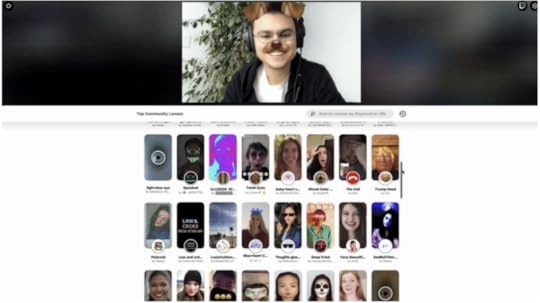 Photo courtesy of The Verge
Photo courtesy of The VergeBringing Snapchat to Desktop
By bringing the Snap Camera to desktop, the company may be able to reach a new demographic of users. Specifically, older demographics who find the mobile-only Snapchat format confusing or inconvenient. Gen Zs, the generation that consists of teenagers in the 13 to 17 age range, currently make up the majority of Snapchat’s user base. Additionally, the desktop app may attract more online gamers. All possibilities point to developers having the opportunity to reach even more users with their lens creations.
Snap’s latest earnings report suggests that the company could sure use a win right now. The report showed a drop of 2 million daily active users, down from the previous quarter. As a result, Snap needs to pull out all the stops to boost itself in unique and inventive ways. The desktop app is a step in the right direction, although we still have to wait and see how well it is received by users. It wouldn’t be a surprise to see even more coming from Snap in the months ahead.
The one downside to the desktop Snap Camera is you can’t log in to your Snapchat account, which means you can’t carry over streaks or chats with friends that you have going on in the mobile app. But perhaps if the product proves successful, Snap might meet the demand and make that capability possible. If that happens, Snapchat could see a boom in usage.
“As we’re launching this product, we think it’s such a huge thing for us,” Pilipski told The Verge. “It’s going to shape our roadmap in ways that we really don’t understand right now.”
We’ll just have to wait and see what the majority thinks of the new desktop app. For now, desktop loyalists, gamers, and co-workers are going to have a lot of fun from the comfort of their desks.
Written by Anna Hubbel, writer at AdvertiseMint, Facebook ads company
The post New to Snapchat: The Snap Camera, a Desktop Feature appeared first on AdvertiseMint.
Running for Office? Here’s the 101 on Facebook Candidate Videos
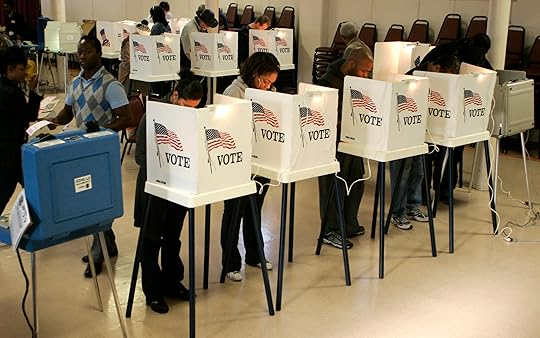 November 1, 2018
November 1, 2018Anna Hubbel, writer at AdvertiseMint, Facebook advertising company
 Photo Reutuers/Danny Moloshok
Photo Reutuers/Danny MoloshokWith the election just around the corner, the pressure is on. Getting voters’ attention is a heightened priority, and simple television ads aren’t going to cut it. As a result, candidates are turning to Facebook to share candidate videos to better reach their constituents.
In spite of all the negative press Facebook has received over the past year and a half in regards to politics, the platform is offering new tools to candidates who are running for office. Specifically, Facebook now allows candidates to upload candidate videos, a feature new to this year’s election. The goal is to help candidates better engage with their audience in honest and transparent ways to promote their message. This article will talk about the basics of Facebook’s candidate video feature.
What Are Candidate Videos?
Facebook now allows candidates running for office in the United States to create a series of 20-second videos that share their message and help constituents understand their political views. Facebook says these videos will be categorized by each race for office and will appear at the top of voters’ News Feeds. It’s a great way to get voters’ attention as soon as they open Facebook, whether it be from their desktops or their mobile devices.
How to Upload a Candidate Video
Uploading a candidate video is simple. On your desktop computer, navigate to your Facebook page and go to Publishing Tools. Next, select Political Content. You can then proceed to upload your videos.
If you do not have an official page, but you do have a Facebook profile, you can still use the feature. Simply navigate to Account Settings and select Campaign Information to upload your videos.
Tips for Filming
Just as with any promotional Facebook video, there are some key tricks of the trade. Facebook has three key recommendations to keep in mind when filming a candidate video.
Film it in vertical (portrait) format. The easiest way to do this is to use your phone.
Film in a well-lit space with little to no background noise.
Make it short, simple, and concise, as you only have 20 seconds per video.
FAQs
Here is a list of frequently asked questions about candidate videos that Facebook addresses on its Politics and Government site, along with the answers.
Who will see this?
All US Facebook users will be asked at the top of their News Feed if they want to access the feature and learn more about their candidates, both at the state and local levels.
How can I find this feature?
Open the Facebook app on your iPhone or Android and locate 2018 Election in the sidebar menu.
How will [Facebook] order the candidates in the future?
All candidates are ordered randomly.
Who is uploading videos?
All US candidates running for office can upload videos.
How many videos are there? What are the questions that the candidates are answering?
Candidates can create four 20-second videos. They will be asked to respond to the following prompts:
Introduce yourself to voters and tell them about the office you’re running for.
What is your top policy priority, and why are you the right person to work on it?
What makes you most qualified to represent your district?
What is the most important goal you hope to accomplish in office and how do you plan to get it done?
How [does Facebook] recommend creating the videos?
As previously mentioned, Facebook recommends that candidates film their videos in vertical format using their smartphones. Facebook also encourages candidates to respond to the aforementioned prompts in their videos.
What happens if I don’t upload a video?
You will not have any videos displayed next to those of other candidates. However, your name and page information will be shown in the feature.
Can I delete or edit a video after I’ve uploaded it?
If you are unhappy with a video after you’ve uploaded it, you have the ability to delete and upload a new one.
Will I see any viewer metrics from the feature?
The number of views your video has is displayed on the page where the videos were uploaded.
Is inclusion in this feature free?
The candidate video feature is completely free for both users to view and candidates to upload.
Can people report content that is not following Facebook Community Standards?
Just as you can report any other inappropriate or violating content on Facebook, you can also report candidate videos if they violate the platform’s standards.
How can I report wrong or missing information in the feature?
You can report missing or inaccurate information directly in the feature by scrolling to the bottom and selecting “Report missing or incorrect info.” From there, you can complete the form, which Facebook will review.
Ever since malicious, political misuse of the platform was discovered, Facebook has been doing what it can to recover and make users, especially brands and politicians, more transparent. Hopefully, the addition of the candidate video feature will contribute to Facebook’s efforts to discourage platform abuse and user data manipulation.
Written by Anna Hubbel, writer at AdvertiseMint, Facebook advertising company
The post Running for Office? Here’s the 101 on Facebook Candidate Videos appeared first on AdvertiseMint.
October 31, 2018
Win $10,000 in the ManyChat Bot Building Contest 2018
 October 31, 2018
October 31, 2018Anna Hubbel, writer at AdvertiseMint, Facebook ad agency

Are you a chatbot creative genius? Do you like a challenge? If you are and you do, you have the chance to share your skills and get a hefty prize to boot. ManyChat is inviting agencies, marketers, and small business owners to build chatbots and submit them in its Bot Building Contest 2018.
If your bot template is selected as a winner, you get a few prizes:
ManyChat will promote your template as a free download.
Your name will be featured on ManyChat’s website and the ManyChat Facebook community.
You may be featured in ManyChat’s bot template store.
You could win up to $3,000 if you win in each of the 20 categories and Freestyle stream.
You could get a free annual subscription to a ManyChat Pro plan of your choice.
As a finalist, you qualify to win the grand prize of $10,000.
The marketing benefits of participating in the contest are an added bonus. Even if you don’t win, you could make the next best bot for your own business. It’s a win-win situation. The contest merely serves as motivation to get your creative wheels spinning.
To enter the contest, you must have a ManyChat account. Through your account, you can submit your template. The contest timeline is as follows:
October 29: The contest officially started and began accepting applications
November 22: The contest closes to new applications
November 22-December 23: The panel of judges selects the winners
December 24: ManyChat announces the winners
March 1: ManyChat announces the grand prize winner
ManyChat is a powerful Facebook Messenger marketing tool that allows you to easily and automatically communicate with customers using chatbots. You can even sell products with ManyChat to make a seamless shopping experience.
Written by Anna Hubbel, writer at AdvertiseMint, Facebook ad agency
The post Win $10,000 in the ManyChat Bot Building Contest 2018 appeared first on AdvertiseMint.
October 30, 2018
Facebook Releases 2018 Third Quarter Earnings Report
 October 30, 2018
October 30, 2018Anne Felicitas, editor at AdvertiseMint, Facebook ads company
 Photo courtesy of Bloomberg. Photo by David Paul Morris.
Photo courtesy of Bloomberg. Photo by David Paul Morris.Today, Facebook released its Q3 2018 earnings report. Here are the highlights.
• Daily active users: 1.49 billion. Increased by 9 percent, year over year.
• Monthly active users: 2.27 billion. Increase by 10 percent, year over year.
• Mobile advertising revenue: represented approximately 92 percent of advertising
revenue for the third quarter of 2018.
During the report, CEO Mark Zuckerberg also mentioned the areas the company is improving.
The company will continue to improve Messenger. Although Messenger 4 is currently rolling out to users, Facebook still aims to make Messenger fast and simpler, adding more utility features, such as payments that allow users to pay for items through the app.
Despite Facebook’s Stories’ slow growth, Facebook will still work on shifting Facebook from a News Feed-focused platform to a Stories-focused platform. During this shift, the company will find ways to make Facebook Stories ads perform better. Zuckerberg, however, noted that during the transition, revenue growth may slow. He also expects the News Feed to be the main driver of growth over the next few years.
Facebook will also work on improving communities during the next 10 years. This entails helping people find dates, jobs, items for sale, events, fundraisers, and volunteer opportunities using its already existing tools.
Finally, Zuckerberg says Facebook will work on improving security, citing its struggle with last month’s hack.
Written by Anne Felicitas, editor at AdvertiseMint, Facebook ads company
The post Facebook Releases 2018 Third Quarter Earnings Report appeared first on AdvertiseMint.
Cruz vs O’Rourke: Using Facebook Ads to Predict Election Outcome
 October 30, 2018
October 30, 2018Anne Felicitas, editor at AdvertiseMint, Facebook advertising agency
 Ads run by Ted Cruz
Ads run by Ted CruzCan Facebook influence an election? It depends on you who ask.
If you ask former president Barack Obama, he might say yes. After Donald Trump won the presidency, nine days after Mark Zuckerberg dismissed the idea that fake news on his platform influenced the election, Obama, who believed the strong impact of fake news, advised the young CEO to assuage the spread of false news on his social media network. If you ask Max Read, a New York Magazine journalist, if Facebook can influence an election, he too would agree, citing misinformation’s effect on voters’ perspectives.
Of course, no one can know for certain whether Facebook alone can change the outcome of the election. Other strategic choices, such as campaigning at the right states and using the right polling data, can affect a candidate’s success. Nevertheless, campaigning is an important part of winning a political position, and where and how you campaign adds an even heavier weight on the outcome.
For Read, and maybe for Obama, fake news helped Trump win the presidency. But can Facebook ads, particularly, influence an election? Can it propel candidates to their coveted political positions? For the purpose of this experiment, let’s say it could. Let’s assume Facebook ads alone could affect election results.
In this experiment, I’m predicting the next senator of Texas by analyzing the October Facebook ad campaigns of the candidates Ted Cruz and Beto O’Rourke. The candidate with the highest-rated political campaign will be the predicted winner. I’ll rate, from a score of one to five, their campaigns according to the following criteria: spend, variety of ad creatives, media, ad copy, variety of ad formats, and clear objectives.
Spend
 O’Rourke’s total ad spend
O’Rourke’s total ad spend Cruz’s total ad spend
Cruz’s total ad spendThe higher the spend, the better campaigns will perform for several reasons. One, the higher the budget, the more resources available to A/B test ads. A/B testing is an important part of advertising because it allows the candidates to run the best performing ads, which cost less. Second, Facebook advertising is an auction in which the candidates must bid higher than their competitors’ to win a spot on Facebook’s feed. Third, a bigger budget allows them to scale campaigns.
O’Rourke is spending significantly more than his Republican opponent, Cruz, likely because Cruz is investing heavily on other platforms, like TV or radio. But I’m not here to judge other platforms. I’m here to judge Facebook ads.
Since O’Rourke has a budget large enough to A/B test constantly, bid higher in auctions, and scale campaigns, he receives a five out of five. Although Cruz has a lower score, a six-figure budget is ideal for a serious campaign. I also award him a five out of five.
O’Rourke: 5/5
Cruz: 5/5
Variety of Ad Creatives
Refreshing your creatives can significantly improve campaign performance. Refreshing ads every two weeks, as Facebook suggests, will keep the audience interested. Neglect to do so, and the audience will experience ad fatigue. To determine whether the candidates have good ad variety, I peeked into the number of ads they run to date. While O’Rourke runs 7,504 ads, Cruz runs 344. Cruz has a significantly smaller number of ads likely because of his smaller budget. As mentioned, the bigger the budget, the more resources to A/B test and scale, which both require creating new ads.
Scrolling through both candidate’s ad archives, I find O’Rourke has more ad variety. He runs ads of different formats, media, video sizes, and objectives. Some videos show him speaking in front of the camera, while others feature homemade square videos of supporters encouraging Americans to vote. Some ads feature interviews, while others feature images of his campaign volunteers. Cruz has less ad variety. Most of his campaigns are professionally edited horizontal videos and images, either featuring him or his opponent. Much of his creatives are similar with a slight copy or image variation.
 Cruz’s ads are mostly horizontal images and videos, with one or two square images.
Cruz’s ads are mostly horizontal images and videos, with one or two square images.
O’Rourke: 4/5
Cruz: 3/5
Media
Media occupies a significant part of ads and determine whether users will stop mid-scroll on their feeds. If using images, they must be crisp, clear, and attractive. If using videos, they must be short and vertical with subtitles underneath for sound-off viewers.
O’Rourke’s campaign consists of a few square videos and numerous horizontal videos, some with subtitles. O’Rourke has no vertical videos, a major disadvantage. Because the vertical format fills an entire phone screen, it’s ideal for attracting and arresting the attention of mobile users. O’Rourke’s videos are also longer than the recommended maximum of 30 seconds. The videos run from 44 seconds to one minute, not the recommended length. While some of his videos are reposts of news snippets and clips of him speaking directly to his audience, a large bulk of his videos are unedited, personalized videos by his supporters, lending a look of authenticity. This is advantageous to his campaign because most people on Facebook prefer amateur videos taken by regular users than professionally edited videos taken by an organization.
 O’Rourke’s ads feature supporters in horizontal videos.
O’Rourke’s ads feature supporters in horizontal videos.Ted Cruz, too, runs both video and image ads. Unlike O’Rourke, his video and image ads are all in the horizontal format (except for one vertical video ad), a format least recommended by advertisers. However, where Cruz fails, he makes up for his video length, which all follow the recommended 30-second maximum. Unfortunately, some of his videos don’t have captions, a major disadvantage, as most users watch videos with sound off. Cruz’s videos, reminiscent of a TV commercial, are all professionally edited, which may repel users.
 Many of Cruz’s ads feature O’Rourke
Many of Cruz’s ads feature O’Rourke
O’Rourke: 3/5
Cruz: 2/5
Ad Copy
Although the ad’s media receives the most attention, the copy should still be well crafted. Good copies are short, readable, complementary to the media, and concisely delivers the main message.
O’Rourke’s copies are mostly long, with no line breaks or emojis, making the ad appear unorganized, cumbersome, and messy. Because the copies are long, some readers may find the ad too wordy, too intimidating to read. Additionally, part of the message is truncated because the length is too long. Some of the copies have Spanish versions, allowing his message to reach the Spanish-speaking community.
 O’Rourke copies are long. Some have Spanish versions.
O’Rourke copies are long. Some have Spanish versions.Ted Cruz’s copies are short, taking up three to four lines. The copies also feature emojis to attract the eye and add visual appeal. The line breaks separate paragraphs, making the copy look readable, clean, and well-organized. Some of the ad copies also have Spanish variations to appeal to the Spanish-speaking community.
 Ted Cruz’s copies are short
Ted Cruz’s copies are short
O’Rourke: 2/5
Cruz: 5/5
Variety of Ad Formats
Using different ad formats reduces ad fatigue. Although image and video ads are the most used formats, other formats exist, such as Instant Experience, Carousel, and Slideshow.
O’Rourke’s campaign consists of images and videos, with few carousel ads. Cruz’s campaign consists of image ads, video ads, and one carousel ad. Both candidates don’t have a large variety of ad formats. However, O’Rourke has more advantage over Cruz because his video ads are a combination of square and horizontal while Cruz only has horizontal videos, save one or two square videos.
O’Rourke: 2/5
Cruz: 1/5
Clear Objectives
A campaign can’t perform well if it doesn’t have a clear objective. Before these candidates can start a campaign on Facebook, they must first clearly understand their campaign goals. Do they want to increase donations? Do they want supporters to understand their stances or do they want them to join a local event? The objective dictates which ad format to use and appears in the copy, the media, and the call-to-action button.
O’Rourke’s October campaign focuses on raising awareness, encouraging people to vote, increasing donations, and increasing event turnouts. To achieve these goals, the candidate runs a few videos ads of himself, briefly discussing his stances on political issues. Those videos are accompanied by long copies that summarize the message of the video. He also runs video ads featuring celebrities and supporters encouraging people to vote. Along with his video ads, he also runs image ads that encourage supports to donate and join events. Those ads contain the appropriate CTA buttons, “view event” and “donate now.”
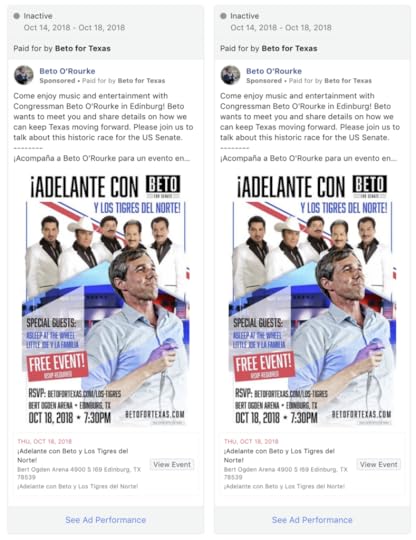 O’Rourke matches event objective with “view event” CTA.
O’Rourke matches event objective with “view event” CTA.In contrast, Cruz’s campaign, although also focusing on awareness, concentrates on donations. To raise awareness, he runs image ads featuring himself, his name, and his opponent’s stances on issues in the copy. He also runs video ads that center on O’Rourke, discussing his stances while images of him appear on screen. Unlike O’Rourke, Cruz spends no time speaking about himself and his beliefs and, instead, focuses on his opponent, O’Rourke. To increase donations, Cruz runs image ads featuring his portrait, short copies, and a “learn more” CTA, an odd choice compared to O’Rourke’s “donate now” CTA. Cruz’s objectives are not as clear as his opponent’s, since, instead of raising awareness on himself, he raises awareness on his opponents. Instead of giving a clear CTA for donations, he uses a “learn more” CTA that is better suited for an awareness ad.
 Cruz matches donation ads with “learn more” CTA.
Cruz matches donation ads with “learn more” CTA.
O’Rourke: 4/5
Cruz: 2/5
And the Winner Is…
Here’s a tally of each candidate’s score:
Spend
O’Rourke: 5/5
Cruz: 5/5
Variety of Ad Creatives
O’Rourke: 4/5
Cruz: 3/5
Media
O’Rourke: 3/5
Cruz: 2/5
Ad Copy
O’Rourke: 2/5
Cruz: 5/5
Variety of Ad Formats
O’Rourke: 2/5
Cruz: 1/5
Objectives
O’Rourke: 4/5
Cruz: 2/5 \
Total
O’Rourke: 20/30
Cruz: 17/30
O’Rourke wins by 3 points. Because his Facebook ad campaign bests Cruz’s, he is the predicted winner of this year’s election for the Senator of Texas.
Can Facebook Ads Influence an Election?
You may not be convinced that a social media platform can affect the outcome of elections. You may side with the critics who argue that to win elections, each candidate must make the right strategic choices, such as referencing the right polling data and campaigning at the right cities or states. You may also side with this research that asserts campaign outreach has zero effect on voters. No matter your stance, take this experiment with a grain of salt because it is simply that, an experiment. Also, recall that in this experiment, we assume that Facebook ads alone can affect elections outcomes. If results reveal Cruz to be the winner, you can dismiss this experiment as amateurish, akin to the World Cup predictions of Paul the Octopus. If O’Rourke emerges the winner, well, perhaps Facebook ads have at least a little bit of influence after all.
Written by Anne Felicitas, editor at AdvertiseMint, Facebook advertising agency
The post Cruz vs O’Rourke: Using Facebook Ads to Predict Election Outcome appeared first on AdvertiseMint.
October 25, 2018
20 Instagram Ads That Rock and Why
 October 26, 2018
October 26, 2018Anna Hubbel, writer at AdvertiseMint, Facebook advertising company

The popularity of Instagram advertising is booming as the platform’s user base continues to grow. In June, Instagram reached a major milestone of one billion monthly users. As a result, advertisers are flocking to Instagram to reach more people, particularly, the Gen Z generation. Using Instagram’s variety of selling tools, like Instagram’s Shopping tags, you can use the platform to acquire more sales for your business.
However, Instagram doesn’t do all the work for you. You need to exert your own creative elbow grease to generate the results you want through your Instagram campaign. But what makes a good Instagram ad? There are qualities that exceptional ads typically have. Usually, a great Instagram ad does at least a few of the following: educates, entertains, engages, provides a value proposition, provides social proof, evokes an emotion, has high-quality images or videos, features the product, and implements good branding. Finally, a good Instagram ad is optimized for mobile screens.
While imitation may be the sincerest form of flattery, we know there are some restrictions. For example, mimicking another brand’s social media and word for word, image for image, is an infringement on that brand’s intellectual property. If you want to refresh your ads with better creatives, you don’t need to copy word for word, image for image. Instead, you can get serious inspiration for your own unique ad by looking at ads other brands are showing off (for good reason). In this article, we’ll look at some examples of exceptional Instagram ads that will hopefully inspire you.
1. Shapermint
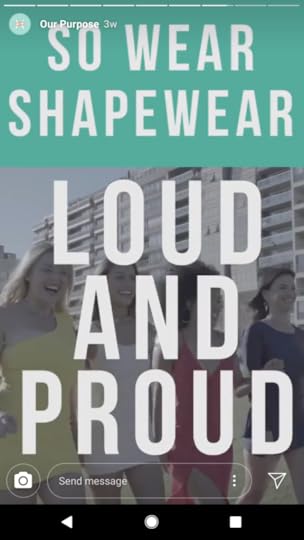
Shapermint is a brand that sells shapewear, clothing that slims women’s bodies. In this Stories ad, Shapermint uses a series of video clips and text overlays to show women of various shapes and sizes wearing Shapermint clothing with confidence. The ad promotes body confidence and pride, no matter the body shape or size.
In addition to using high-quality video, Shapermint uses large, bold text to get your attention and manipulate your emotion. The brand cleverly uses strong, empowering language, such as “We are more than just our bodies,” “Confidence,” “Comfortable in your skin,” and “In charge.” Using this kind of language, Shapermint inspires women, likening the purchase of its products to joining a social movement.
The ad also incorporates good branding throughout the video. Where there isn’t footage of women wearing the product, Shapermint uses text overlays with colored backgrounds that match the brand’s color scheme. Additionally, the ad is optimized well for mobile, dividing up the screen vertically where appropriate and filling up the vertical space.
2. Starbucks
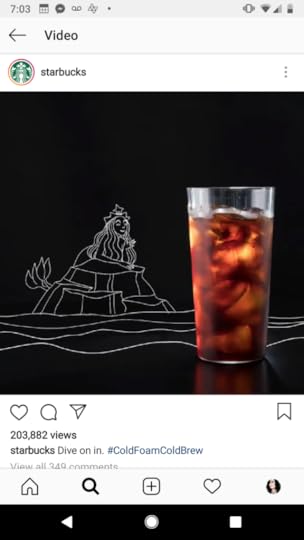
In this short Instagram video, Starbucks grabs your attention with a simple but effective animation. The mermaid dives into the ocean, splashing water into the pictured coffee drink, which foams at the top. The animation highlights Starbucks’ cold foam beverage with only a very brief caption: “Dive on in. #ColdFoamColdBrew.”
In addition to grabbing your attention right away and showing you the product it’s promoting very clearly, Starbucks also implements good branding in this animation. Specifically, the mermaid in the animation is the woman from the Starbucks logo, and the black background and chalk-like white lines match the aesthetic of a Starbucks cafe.
3. Mrs. Meyer’s Clean Day
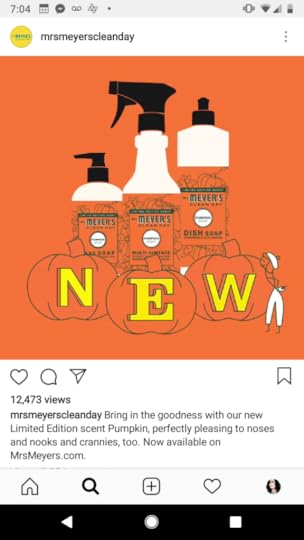
Mrs. Meyer’s Clean Day is a brand of household cleaning products. Relevance, color, and attention make this a great video ad. First, the video is relevant to the time of year, October, using the color orange and pumpkin carving typically associated with Halloween. Next, after the cartoon character carves the word “NEW” into the three pumpkins, Mrs. Meyer’s effectively grabs your attention when three of the brand’s cleaning products pop up from each of the pumpkins. The image fills the screen and shows you clearly the products the brand is marketing: limited edition, pumpkin-scented cleaning products.
4. Function of Beauty
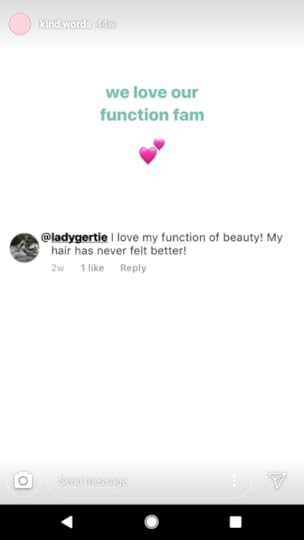
Function of Beauty sells customized shampoos and conditioners. This Stories ad is a great example of using social proof to build customer trust. Throughout the Kind Words story, Function of Beauty presents itself as a reputable brand by showing positive customer testimonials and online reviews of its products.
Customers are more likely to buy from a brand with a lot of positive reviews and testimonials. This ad creatively uses the Instagram Stories platform to get social proof of product reviews out there.
5. IHOP
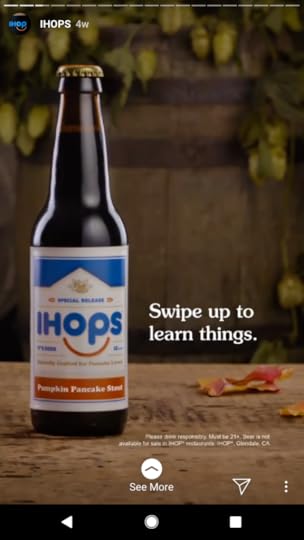
The International House of Pancakes (IHOP) offers more than just pancakes, as this Instagram Stories ad proves. This vertical ad implements the IHOP brand and humor throughout while also encouraging engagement. To promote its Pumpkin Pancake Stout, IHOP uses a series of close-ups of the beverage, as well as a video of the product being made. Periodically, IHOP presents call-to-actions, as seen in the image above with the “See More” swipe-up option, using humor to draw attention to it: “Swipe up to learn things.”
The series of Stories also include fall themes relevant to the season, such as a hand popping up from a pile of autumn leaves holding a bottle of the “Pancakin’ beer.” Additionally, IHOP throws in “I’m a pancake beer, ask me a question” bubbles to get its audience engaged.
6. Calvin Klein
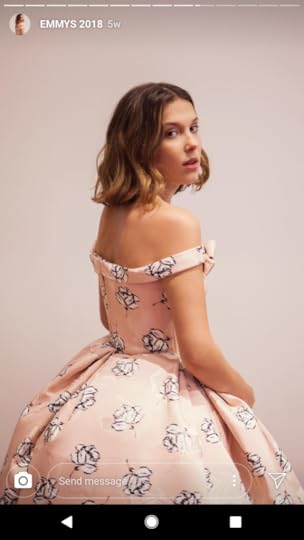
Calvin Klein is a sophisticated clothing and fashion brand, and we see that sophistication shine through in this Instagram Stories ad. The ad, titled “EMMY’S 2018,” goes behind the scenes in an “exclusive look” at the making of the brand’s custom Emmy looks. The video shows close-ups of sewing, pinning, and hemming of the dress in the image above. Once the dress is finished, Calvin Klein shows the model wearing it, zooming in on different parts of the dress. Watching this ad, you can’t help but feel both impressed and a little nostalgic.
The ad concludes with a close-up of the Calvin Klein label, leaving the brand name at the forefront of your mind.
7. Dove
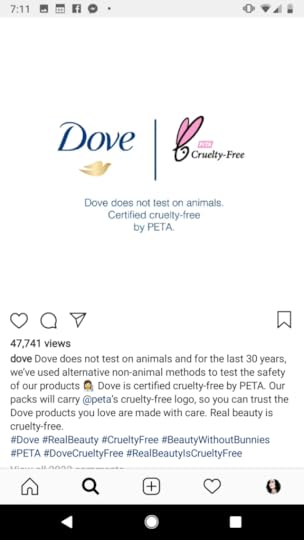
Dove uses clever branding by showing the classic Dove logo, but the dove under the name changes shape into different animals to get your attention, as well as to clearly convey the main message, which is Dove is cruelty-free. Next, the social proof comes in with the cruelty-free stamp by PETA. The approval by PETA tells you that Dove is an animal-loving brand that can be trusted.
8. WeddingWire
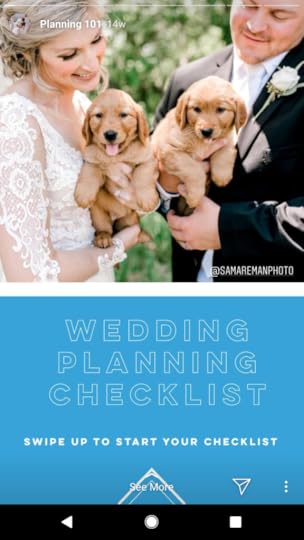
WeddingWire, a wedding planning business, engages with its audience in this mobile-optimized ad. It simply invites you to start your wedding planning list, keeping it relevant to what the business does (i.e. wedding planning) without pushing a sale.
The ad also appeals to our emotions. Who doesn’t love puppies? Combine puppies with weddings, the happiest days of people’s lives, and you can’t help but feel good looking at this ad.
9. Gap
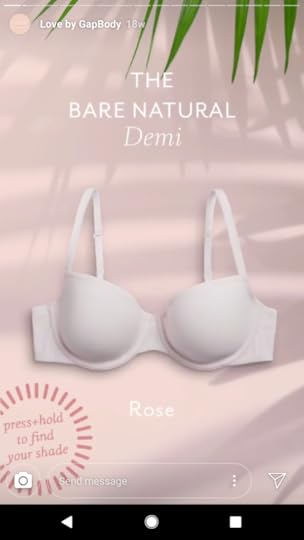
Gap, a long withstanding clothing retailer, uses this Instagram ad to feature its bra selection in different color variations, bringing the store window experience to your phone. As the bra colors change, you’re also encouraged to engage with the ad in the bottom left corner with a call to action that invites you to “press + hold to find your shade.” This call to action adds a personalized experience to get you interested and shopping.
10. Apple
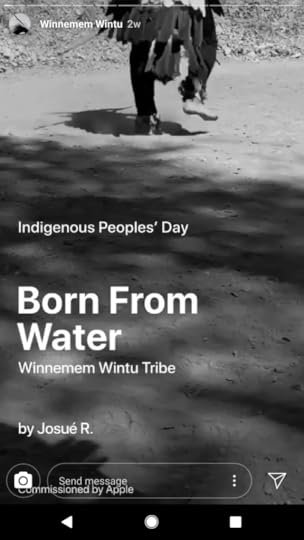
Although this Instagram Stories ad doesn’t feature any Apple products, it promotes itself by implying that the video was captured with an iPhone. It also uses an artistic black-and-white perspective associated with Apple’s image as an artsy technology brand.
The ad is socially relevant by recognizing Indigenous Peoples’ Day, highlighting the Winnemem Wintu tribe to establish the brand as culturally diverse. The “Born From Water” headline holds emotional weight, helping us appreciate the origins of the tribe.
11. Regal Cinemas
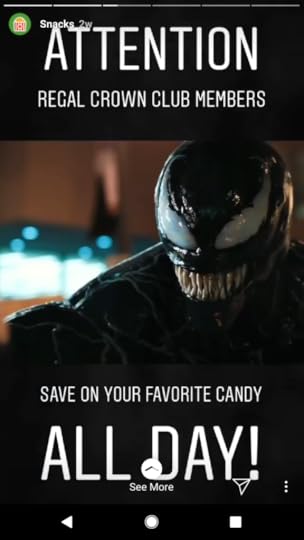
Regal Cinemas promotes its Regal Crown Club membership in this Stories ad. The mobile-optimized ad is simple, using a clip from a current movie shown at Regal theaters (Venom) to catch your attention. In addition to clearly headlining the ad with “Attention Regal Crown Club Members,” Regal attracts interest with the incentive to “save on your favorite candy all day!”. With the image of a hungry Venom, the ad is relevant both to the message and the movie-going experience of Regal Cinemas. The ad then caps off with a “see more” swipe-up call to action.
12. Ben & Jerry’s
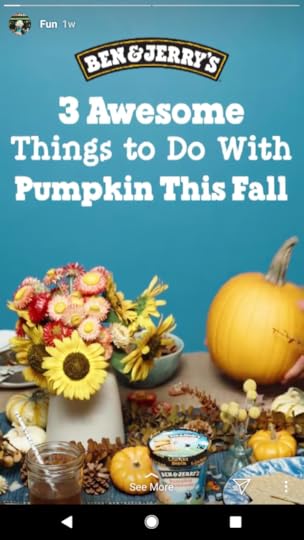
Ben & Jerry’s has no trouble promoting its ice cream even in the colder months. The brand uses seasonal relevance to engage its audience in this Instagram ad, making it more of an article headline than an ad promoting sales. It peaks your curiosity, inviting you to discover the three “Awesome Things to Do With Pumpkin This Fall” by swiping up on “see more.”
While the foreground includes autumn-related objects, such as pumpkins and leaves, the ad still incorporates branding. We see this with the subtle placement of the Ben & Jerry’s ice cream carton at the bottom, as well as the light blue background and Ben & Jerry’s logo at the top.
13. Stitch Fix
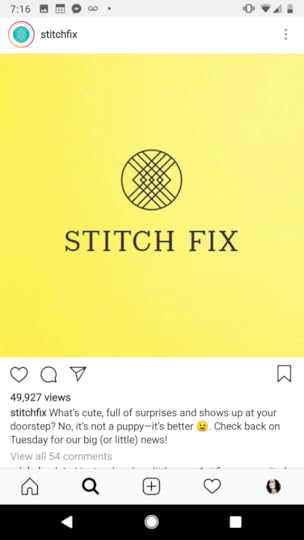
Stitch Fix, a subscription fashion brand that delivers personalized outfits to your doorstep, creates a little mystery and curiosity in this Instagram ad. In a 3-2-1 countdown video, Stitch Fix announces, “We’ve got some (little) news!” and concludes simply with the Stitch Fix logo. You’re left wondering what the news is, so you naturally look at the caption for an explanation. The caption tells you to “check back” to hear the “big (or little) news!” By drawing your attention to the caption and then saying you have to check back later to find the news, Stitch Fix is able to engage its audience and keep them returning for more.
14. Glade
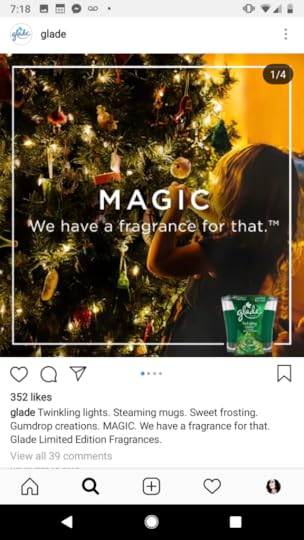
Glade, the fragrance brand, gets in the holiday spirit in this ad. The first image is a simple video animation: the lights on the tree twinkle while everything else is still. It’s an adorable image that appeals to your nostalgic and warm family feelings that come during the holidays. Glade plays up the sparkle of the image with a simple text overlay: “Magic: We have a fragrance for that,” as well as a caption that sets the holiday scene. The ad also includes subtle but effective branding with the small placement of a Glade candle in the bottom-right corner. You can almost smell Christmas trees and hot cocoa just looking at the image.
Swiping through the other images in the ad, you get more images paired with specific fragrances. For example, the second image shows a child with a cozy, warm beverage, and only the steam rising from the mug and the snow outside the window are moving. In the bottom right corner, we see a different Glade fragrance that fits the setting. The other two images follow the same pattern. Overall, branding and emotion are the qualities that stand out in this ad.
15. Yankee Candle
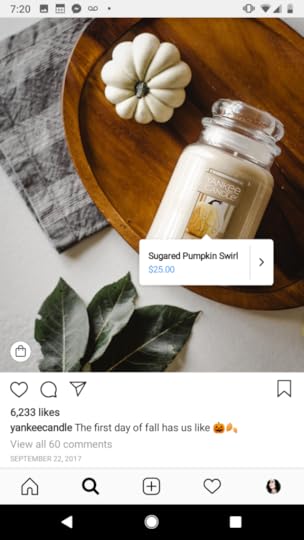
Yankee Candle gives us a perfect example of how to use Shoppable tags. The image is simple, showing a seasonal pumpkin candle in a professionally arranged photo. When you tap on the image, a tag pops up with the cost of the candle. If you click on the arrow, you’re directed to a page with more information about the product, as well as a link to Yankee’s website where you can buy it. Using Shoppable tags in this way allows you to create a high-quality image, engage with customers, and drive website traffic in a seamless manner.
16. Buffy
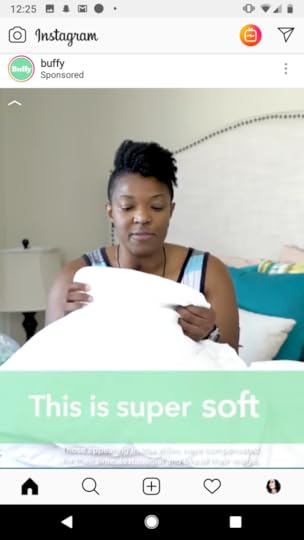
Buffy promotes its comforters using social proof as its primary strategy in this particular ad. The video shows a customer’s review of a Buffy comforter, using a light green bar at the bottom behind the captions to match the brand’s color scheme, which demonstrates good branding as well. In the video, the customer is using the product while she praises it, giving it her stamp of approval. The caption includes a quote by the customer and five stars. This strategy helps build trust: you almost feel like it’s an organic post by a regular user rather than a sponsored ad. In addition, the “learn more” call-to-action allows you to engage with the post, driving traffic to the Buffy website to buy this highly praised comforter.
17. Payoff

Payoff is a loan service that helps people pay off debt. In this ad, Payoff elicits emotion, employs good branding, and uses a little bit of social proof. First, the “Bye Debt” gives you a sense of relief. Finally, you’ve received the answer to your money problems. Second, we see good branding with the open laptop showing Payoff in action and the use of the brand color, pink, with the “mearn more” call-to-action.
Finally, we see the social proof in the caption, where Payoff points out its recognition by prominent entities like Credit Karma, Forbes, Wall Street Journal, Glamour, and Yahoo, helping you see how trustworthy the company must be.
18. Waking Beauty
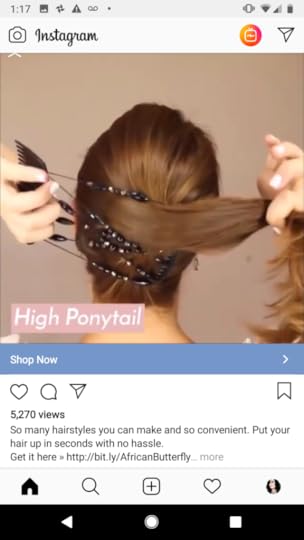
Waking Beauty, a company that sells hair and skin products, uses a tutorial video to both educate and stun its audience. The video shows all the various ways you can use a Waking Beauty hair comb to make stunning hairstyles. It makes you want to try the product. To drive traffic to its website, Waking Beauty also includes a “shop now” call to action.
19. Sleep Number
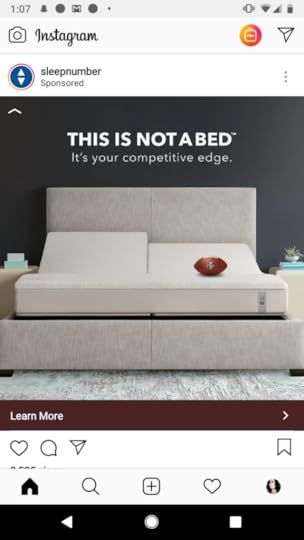
Relevance and social proof are key in this Sleep Number ad. With football season well underway, Sleep Number ties it together with the promotion of its bed, using a football animation bouncing on the bed and referring to the brand’s partnership with the NFL in providing better sleep. The ad then appeals to the competitive side of football fans with the line “This is not a bed: It’s your competitive edge.” If you are a football fan, you’re likely tempted to at least tap the “Learn More” call to action to browse Sleep Number’s bed selection on its website.
20. Wayfair
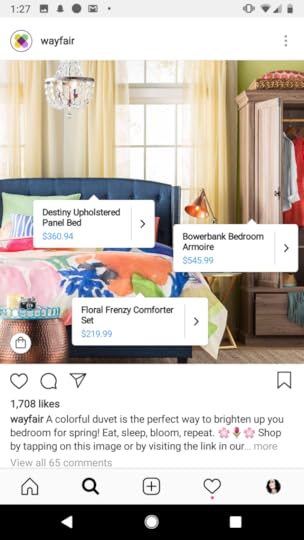
Wayfair, an online store for furniture and other household necessities and decor, gives us another example of Shoppable tags in action. The company uses a high-quality photo of a nicely decorated bedroom to feature its products in an appealing fashion. You can then tap on items in the image to see how much they cost and on the arrow to learn more about the product you’re interested in. This strategy is an effective way to capitalize on shoppers’ household tastes at their highest point of interest to get them to visit Wayfair’s website and easily buy the products in the image in a seamless experience.
The Next Step
Think you have a better feel for what a good Instagram ad can look like? Jot down any ideas these examples spark in the creative nook of your brain and get to work. Your ad could be the next one to be listed among the greats.
Written by Anna Hubbel, writer at AdvertiseMint, Facebook advertising company
The post 20 Instagram Ads That Rock and Why appeared first on AdvertiseMint.
October 24, 2018
Messenger 4 Is Coming Soon to Smartphones Near You
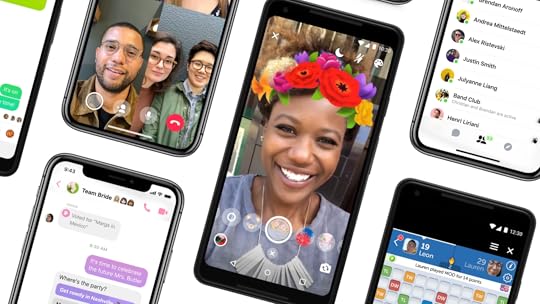 October 24, 2018
October 24, 2018Anne Felicitas, editor at AdvertiseMint, Facebook ad agency
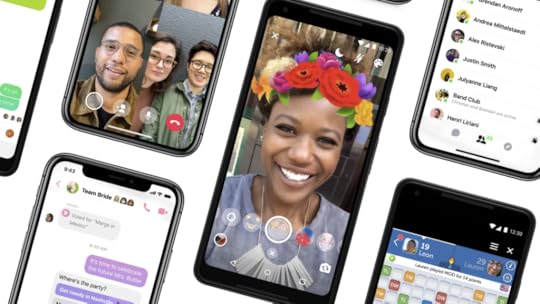 Photo courtesy of messengernews.fb.com
Photo courtesy of messengernews.fb.comIf it ain’t broke, don’t fix it—right? Not for Facebook.
In a status update, Facebook’s head of Messenger David Marcus announced a new and improved Messenger: Messenger 4. Although many may consider Messenger’s design and functionality fine as it is, the messaging app released updates that simplify the app and make it appealing to younger users (cough—Snapchat users—cough).
“Really proud of the Messenger team for releasing the new simplified, streamlined, better-in-all-ways Messenger,” said Marcus in his Facebook status update.
The new Messenger, according to the Messenger News post, has reduced number of tabs. Rather than nine, Messenger now has three. One for conversations, one for contact lists, and one for groups.
The first tab, dubbed Chats, contains one-on-one conversations and group chats with friends. The second, People, contains a friends list that users can scroll through to see who’s online to chat (you up?). The third—given a familiar name that recalls a feature of a rival app (Snapchat)—Discover, contains business accounts, games, news, and more.
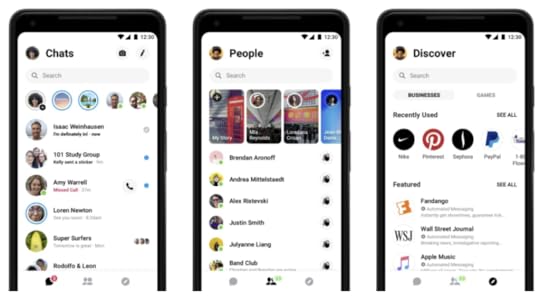 Photo courtesy of messengernews.fb.com
Photo courtesy of messengernews.fb.comWith the functional updates come the impractical, meant to excite younger users. Located at the top-right corner of the screen, Messenger 4 has a camera for selfies, likely aimed at attracting Instagram and Snapchat fans. It also has a more colorful design. The app has a new color gradient feature that allows users to change the color of their message bubbles “to reflect [their] mood and topic of conversation,” bubbles that change hues as they scroll.
While some Messenger fans approve of the changes (Looking forward to trying this out! So much fun here), some don’t.
“Have you considered not forcing a list of stories at the top that I’ve never used and didn’t ask for?” commented one displeased Richard Lawler, Engadget’s senior news editor.
The Messenger 4 updates, rolling out now, will come in phases. The first phase includes the aforementioned features, and the second phase will include dark mode and a new interface that reduces screen glare. Maybe Lawler will find the second phase’s update more appealing.
Written by Anne Felicitas, editor at AdvertiseMint, Facebook ad agency
The post Messenger 4 Is Coming Soon to Smartphones Near You appeared first on AdvertiseMint.
October 23, 2018
Deleting Your Facebook Account: What You Need to Know
 October 23, 2018
October 23, 2018Anne Felicitas, editor at AdvertiseMint, Facebook advertising company
 Thought Catalog / Unsplash
Thought Catalog / UnsplashYou face a tough decision: should you delete your Facebook account?
As torn as you are, know you are not alone. A Google search for the words “Facebook account” tellingly show a new trend: two of the top three search results are articles that teach people how to permanently delete Facebook from their lives.
 Search yields articles on how to delete Facebook.
Search yields articles on how to delete Facebook.You, and the many others on the Internet, have good reasons for leaving. Why stay when, in the past two years alone, Facebook allowed politically divisive Russian ads and fake news to proliferate on its platform. Why place your trust in a company that concealed the data breach of 87 million users. Just when the wounds from those betrayals are healing, you learn of a Facebook security issue that exposed user accounts to hackers. You want to leave, and that’s not surprising.
You might, however, have second thoughts. A loyal Facebook user for many years, you may mourn the loss of the memories you built: your pictures that detail your life from high school to present day, your connections, your witty status updates, the lovely birthday greetings friends posted on your timeline throughout the years. When your Facebook account is gone, is it gone for good?
Deleting Your Account: The Aftermath
According to a post in Facebook’s help center, you can’t retrieve a deleted account, and when your deleted account goes to the social media afterlife, your profile, photos, posts, videos, and everything you posted on Facebook will go with it. And like your deleted account, you can’t retrieve anything you posted or added on Facebook unless you download your data and archives before deleting your account.
Of course, you may no longer care about the memories you built on Facebook. To you, Facebook is just another MySpace, and you’re ready to move on to another social media app. Unfortunately, moving on may be more difficult than you expected. After deleting your account, you can’t use Facebook Messenger and access the apps for which you use your Facebook login, like Spotify, Pinterest, and Instagram. For the latter issue, you would need to contact the apps and websites to recover your accounts. Deleting your Facebook account may be a bigger hassle than you expected, especially when so much of your online activities are intertwined.
Deactivation, a Less Drastic Solution
If you want a less drastic solution (perhaps you want a temporary break rather than a permanent divorce from Facebook), you can, instead, deactivate your account. Unlike deletion, when you deactivate your account, you won’t lose your photos and videos; you can still use Messenger; you can still use your Facebook login to access your connected apps, and you can still return any time you want. Although you are no longer visible to your Facebook friends (people won’t see and can’t visit your profile), you can still connect with those friends on Messenger. Deactivation allows you to take all the time you need and return whenever you’re ready, whenever you find a reason to keep your Facebook account.
You Deleted Your Account. Now What?
 Radu Florin / Unsplash
Radu Florin / UnsplashAs torn as you are, you weighed your options and deleted your Facebook account. Sure, you may have abandoned the platform on which you built memories and gained friends throughout the years, but after recent events, you can no longer support the company that failed its users too many times—it’s understandable.
But if you find yourself missing Facebook, if you suddenly have the desire to restore your account, there is still hope. Facebook gives you 30 days to finalize your decision, in the event that you begin to have second thoughts. If you log back into your account in less than 30 days, you can still save it. Wait longer than 30 days, and your account is lost forever.
When you delete your Facebook account, is it gone for good? Yes, unless you meet the 30-day grace period. Facebook wouldn’t let you go so easily.
Written by Anne Felicitas, editor at AdvertiseMint, Facebook advertising company.
The post Deleting Your Facebook Account: What You Need to Know appeared first on AdvertiseMint.



